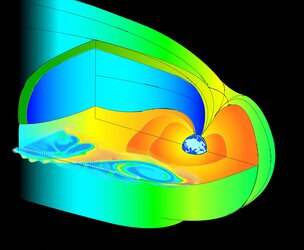Magnetic vortices explain mysterious auroral beads
One solar stormy day in November 2018, 13 spacecraft including ESA’s Cluster mission were in the right place at the right time to spot a process that has never been seen in its entirety before. Their observations explain how vortices at the edge of Earth’s magnetosphere can cause auroral beads to dot the sky a hundred thousand kilometres below.
This connection between auroral beads appearing on Earth’s ‘dayside’ (or Sun-facing side) and the vortices confirms a theory about how these unique auroras – known as beads because they look like a string of pearls hung across the sky – form. As some spacecraft observed the vortices themselves, others saw that a stream of charged particles used the vortices as access points to tunnel down towards Earth’s surface, causing the sky to glow.

The magnetosphere is Earth’s defence against the charged particles and radiation blasted in our direction by the Sun (also known as the solar wind). This defence takes the form of a giant magnetic bubble in the shape of a shield facing the Sun. On 6 November 2018, 12 spacecraft were all located close to the magnetopause – the thin boundary at the outer edge of the magnetosphere – on the night side of Earth, where the magnetosphere stretches out into a tail.
Among the 12 spacecraft located close to the magnetosphere were the four that make up ESA’s Cluster mission, as well as NASA’s four Magnetospheric Multiscale (MMS) spacecraft and three Time History of Events and Macroscale Interactions during Substorms (THEMIS) spacecraft, and JAXA’s Geotail. In addition, a US Defence Meteorological Satellite Program (DMSP) satellite observed the auroral beads from close to Earth’s surface.
“This discovery shows that the Cluster spacecraft are part of a ‘magnetospheric orchestra’ of missions that together enable extra science that is not possible to achieve with each mission individually,” explains Philippe Escoubet, ESA’s Cluster project scientist.
The vortices – which themselves were originally detected by Cluster – are formed when the solar wind blows past the magnetopause. Just as wind on Earth can whip up oceans and clouds, the solar wind can roll up the magnetopause into giant waves comprised of whirlpool-like vortices.
When a vortex is at the ‘goldilocks’ size – not too big, but not too small – electrons from the solar wind swirl around its centre, before entering the magnetosphere, travelling towards and reaching Earth’s upper atmosphere. There, the electrons collide with hydrogen, oxygen and nitrogen, causing them to glow and form an auroral bead in the sky. These round beads – one for each vortex – appear in groups that follow each other across the sky. This is in contrast to ‘normal’ aurora which are flatter, more elongated and not so well organised.

“It’s great to use multi-satellite missions to make connections between dynamics at the edge of the magnetosphere and what we see in the ionosphere far below,” says Steven Petrinec, lead author of the study, which was recently published in Frontiers in Astronomy and Space Science. “Due to the scarcity of observations and sampling locations within the magnetosphere, it is important to take full advantage of multiple mission observations whenever possible to understand the connections between different processes within the large and complex system.”
Since Cluster launched on 16 July 2000, it has revealed a plethora of interesting details about the magnetosphere and its interaction with the solar wind. By making the most detailed investigation yet into how the Sun and Earth interact, Cluster is helping us prepare for the effects of sudden bursts of solar energy here on Earth.
Philippe continues: “Cluster has been operating for almost 22 years now. In the beginning, it was one of the only missions observing the magnetosphere, so we were mainly comparing the four spacecraft with each other. But nowadays we can compare their data with those from other missions, such as MMS and THEMIS.”

This research demonstrates the importance of multiple different spacecraft, each with their own complement of scientific instruments, monitoring the same events from different vantage points.
Simon Wing, a co-author of the study, notes: “This study also highlights the importance of connecting these multi-spacecraft observations with theory. In this case, using the multi-point observations at the magnetopause, the theory is able to predict the dimension of the auroral beads observed by the DMSP satellites in the upper atmosphere.”
Steven, who works on NASA’s MMS mission, adds: “Philippe and I make sure that we get Cluster and MMS working together as closely as possible. For example, Philippe always sends me information about when the two will be physically close, so we can ensure that all the spacecraft are working optimally together when they are monitoring the same region of the magnetosphere.”
Notes for editors
‘Multi-Spacecraft Observations of Fluctuations Occurring Along the Dusk Flank Magnetopause, and Testing the Connection to an Observed Ionospheric Bead’ by Petrinec et al. (2022) is published in Frontiers in Astronomy and Space Sciences. DOI: 10.3389/fspas.2022.827612
A previous paper by Johnson et al. (2021) presented the theory on how structures in the magnetosphere could produce auroral beads close to Earth’s surface.
For more information, please contact ESA Media Relations: media@esa.int















 Germany
Germany
 Austria
Austria
 Belgium
Belgium
 Denmark
Denmark
 Spain
Spain
 Estonia
Estonia
 Finland
Finland
 France
France
 Greece
Greece
 Hungary
Hungary
 Ireland
Ireland
 Italy
Italy
 Luxembourg
Luxembourg
 Norway
Norway
 The Netherlands
The Netherlands
 Poland
Poland
 Portugal
Portugal
 Czechia
Czechia
 Romania
Romania
 United Kingdom
United Kingdom
 Slovenia
Slovenia
 Sweden
Sweden
 Switzerland
Switzerland





























